Stories
Farrys
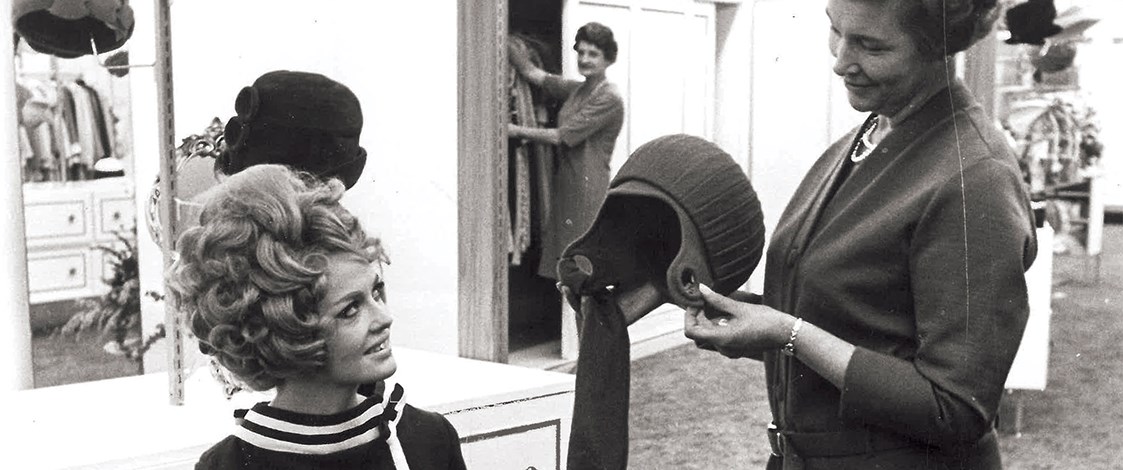
Prominent high fashion retailers for three generations, the Farry family began selling clothing in much humbler circumstances in the late 19th century.
In 1892, Gabriel Farry came from the village of Becharre in the mountains of Lebanon to join the Lebanese community in Dunedin. He set up as a hawker selling fancy goods and clothing door to door. In 1899, he married Jamelie Coory and they had two sons, Joseph and Saba. Family illness and homesickness took the young family back to Lebanon in 1906 where two more children, Mary and John were born. Following Gabriel’s death at the age of 39, the family returned to Dunedin and Joseph and Saba, now teenagers, purchased a horse and cart and set themselves up as hawkers in the Southland area. The horse and cart were later replaced with a van they built from a truck chassis.

Joseph Farry and the van he owned with his brother Saba. Image courtesy of John Farry.
In 1925, the two brothers took the opportunity to join in a business venture with their grandmother, Shariffie Coory, a successful business woman in her own right. Also in 1925, the purchase of a stall at the New Zealand and South Seas Exhibition in Dunedin offered the young entrepreneurs the opportunity to further their ambitions.
Following this experience, Saba and Joseph opened a clothing factory in Dunedin in 1929 under the name of S & J Farry. The brand name chosen for the shirts, pyjamas, overalls and plain work frocks they manufactured was Excell.
With the hard times brought on by the depression of the 1930s the brothers were forced to sell the factory but by the mid-1930s they were back in business. With their respective families, Saba and Joseph rented a warehouse space above a chemist’s shop in Gore and worked together to manufacture and retail goods again.
Saba subsequently opened a drapery store Farrys Ltd in Gore which, from its very early days, had the policy of providing within one store the best styles from the best fashion houses in New Zealand and overseas.
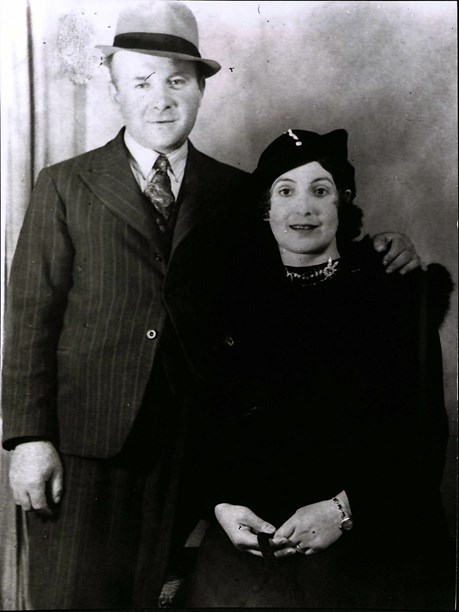
Saba Farry and his wife Badiea. Image courtesy of Dunedin Public Libraries, CC BY 3.0 International Licence.
Saba’s eldest son Gabriel, who entered the business in 1942 during World War ll, recalls that fashion wasn’t terribly exciting at the time, nor was fashionable clothing a priority for most people. By the time his younger brother Tony joined the business in 1946, the war was over and things were looking brighter. In the 1950s, the teddy boy fashion hit retailing and the store did a brisk trade in zoot suits and long jackets with velvet or leopard trim collars.
In 1960, the company bought the premises next to the shop and Farrys Limited developed into a modern department store, ten times its original size. Because of the fashionable labels on offer, among them John Barry, Plummer, Miss Deb, Jag, Rosemarie Muller and Hardy Amies, Farrys soon established itself as a fashion destination for well-dressed women throughout the Southland and Otago regions. From the early 1960s to the 1980s, Gore was touted as having the highest retail spending per person in New Zealand, scarcely surprising given the relative wealth of the area.

A queue to get into a Farrys sale in Gore, 1960s. Image © Farry family archive.
Around 1964, the Farry family opened a specialist women’s store in Invercargill, the fit-out of which was considered very fashion forward for its time. By the end of the 1960s, the Invercargill store was trading so well, a similar store was opened in Dunedin in the newly refurbished Harvest Court Mall in George Street.
Lyn Farry in the millinery department at Farrys and an ad for Farrys Fashion Centre in Dunedin, circa 1969. Images courtesy of Lyn Farry.
With the introduction of such labels as Thornton Hall, Love Story, Charade, Adele Palmer, Suzanne Gregory, Judith Malcolm and Caroline Sills, the Dunedin store catered to a broader demographic. Following overseas trends, Farrys' photoshoots were moved out of the studio and onto the street. Farrys for Women manager Neil Reid used a number of locations around Dunedin for photoshoots, including the waterfront, Olveston Historic Homestead, the Otago Museum grounds and George Street.
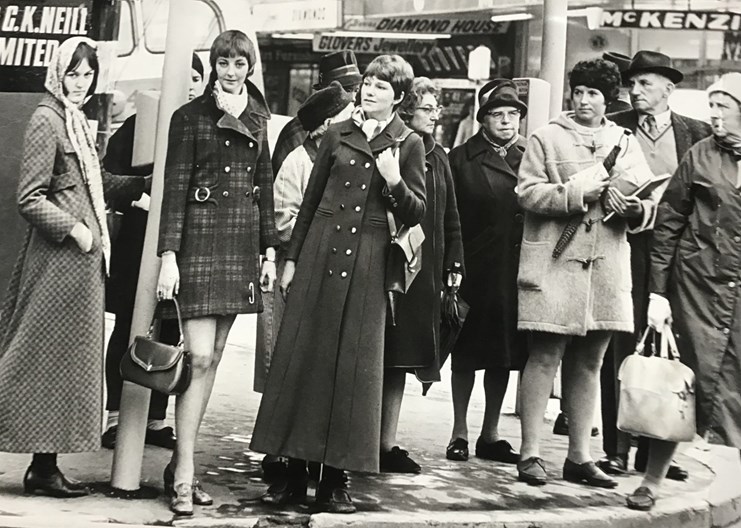
Photoshoot for a coat promotion on George Street, circa 1969. Image © Lyn Farry.
Sadly Tony Farry, at the height of his career and the driving force behind the success of the women’s stores, died tragically while on holiday with his family in 1980. A well-loved figure in fashion circles, he was also known for his community work. Rather than confining fashion to the stores, he gave his support to charitable causes by assisting with many fashion shows off-site.
To make the business work in Tony’s memory, his wife Margaret, his two children Victor and Nichola and his brother Gabriel continued to operate both the Dunedin and Invercargill stores throughout the 1980s and 1990s.
As in previous periods, numerous in-store promotions featuring the latest season’s fashions and new labels were a popular event for Dunedin women. In the 1980s, a fully choreographed charity show in association with Margaret-Farry Williams’ Vanity Walk modelling school proved a very well received event – so much so that it was repeated the following season to large audiences in Gore and Invercargill.
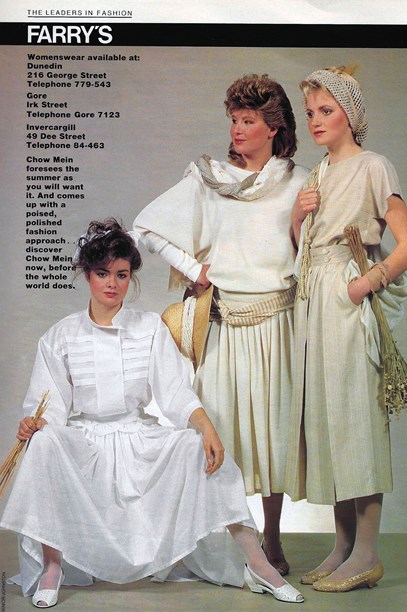
Ad for the Chow Mein label at Farrys, 1983.
Wishing to expand the menswear business beyond Gore, Seba Farry (son of Gabriel and grandson of Saba Snr) opened Farrys for Men at 266 George Street, Dunedin in 1982. This was a large, purpose-built store which became a mecca for the fashion conscious men of Dunedin and the wider Otago community.
In 1992 this entrepreneurial family, wishing to expand yet again, saw Gerard (Gabriel's younger son) carry on the family tradition by opening a menswear store in Wellington. It is still in business today.
In 1998 the Dunedin women’s store moved to share premises with Farrys Menswear which had also opened in Dunedin. The menswear store had been purpose-built and was catering to Otago’s discerning male customers. High-end labels were on offer and the company prided itself on its personalised customer service. With the bringing of the two stores on to the one site, customers were able to browse both men’s and women’s wear by stepping through an opening at either end of a dividing wall. Both stores were run by third generation family members.
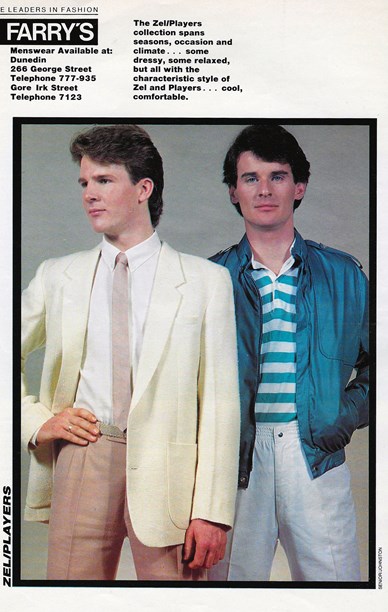
Ad for menswear at Farrys, 1983.
In 2002, Tony’s son Victor moved to Auckland to further his knowledge of the design and production side of the fashion industry. He sold the Dunedin women’s wear store and his sister Nichola took over the Invercargill store which she ran successfully until a move to Auckland resulted in that being sold as well.
Another profound shift in the dynamics of the Farry family occurred with the closing of the iconic Farrys Ltd in Gore. With Gabriel Farry looking toward retirement and no family members living in or near Gore willing to take over, the decision was reluctantly made to shut up shop in July 2011.
Seba Farry, Gabriel’s eldest son, continued to operate the menswear business in Dunedin for many years after the women’s wear outlet closed and he ran this in tandem with a second menswear business he opened in Auckland’s High Street. Eventually, though, the demands of operating the two sites became untenable and the Dunedin outlet was closed. At the end of July 2017, Farrys Menswear Auckland also closed its doors when Seba decided it was time to pursue other interests.
The legacy of Saba Farry senior lives on today with the Wellington menswear store, now in its 25th year, run by his grandson Gerard, and Fredricks Fashion for Men, an Invercargill menswear store operated by a granddaughter Lucy, the daughter of Lila Farry and Victor Farr.
Lila and Victor began dressing the men of the far south in the early 1960s from a store in Bluff. Victor became a local icon and it wasn’t unusual for him to be paid in oysters by customers with whom he had developed a rapport. After 30 years in Bluff, Lila and Victor moved to Invercargill and opened Fredricks Fashion for Men. To encourage the continued growth of the fashion industry in New Zealand, Fredricks has, for many years, sponsored the menswear section of the Hokonui Fashion Awards.
A shared love of fashion, family loyalty and a commitment to quality have ensured the Farrys a lasting place in New Zealand’s fashion retailing history.
Text by Lyn Farry. Banner image © Lyn Farry.
Published March 2020.